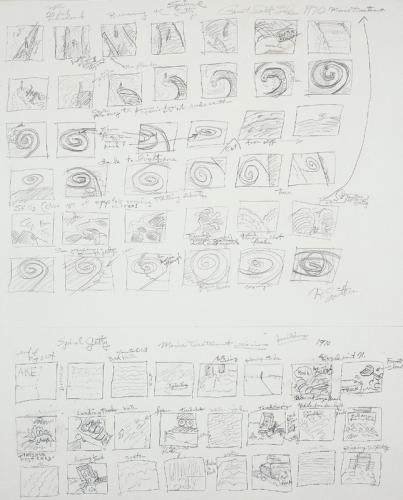“Fiachra Gibbons meets Nuri Bilge Ceylan in his apartment in Istanbul to talk about Mehmet Emin Toprak.” [via David Hudson, quoted by Greg Allen]
The New MoMA: Straight, but not Narrow
 The Times‘ Sarah Boxer walks through Taniguchi & Associates’ soon-to-be-completed MoMA with Glenn Lowry. The early word is, it’s straight.
The Times‘ Sarah Boxer walks through Taniguchi & Associates’ soon-to-be-completed MoMA with Glenn Lowry. The early word is, it’s straight.
“…two huge windows, nearly floor to ceiling, face each other at opposite ends of the Sculpture Garden. Both are topped by anodized aluminum canopies. Both rise straight up from the ground level to the sixth floor. And in this case, Mr. Lowry noted, straight really does mean straight. ‘We designed it so that the facade has zero-degree deflection. There’s no bow.'” Walls, ceilings, joints, mullions, floors, all were designed by T&A to be crisp, rectilinear, minimalist, straight.
But not narrow, Lowry assures. With multiple doors, stairs, escalators and views, the straight new museum will offer a mind-expanding number of alternative experiences of the collection–and, by extension, through the history of art.
Evoking an unintentionally [?] Hitchcockian mental image, Lowry explained, “We don’t want people to feel they’re on a train.” Unless, of course, they’re into that sort of thing.
Try Explaining “Famous Bloggers”
That was my dilemma last night in attending Gothamisty NY Bloggers forum at the Apple store. Like everyone else, I went to drum up traffic for my own weblog.
Sure, some will act like they care about the Freddie Nick vs. Jason feud; a couple of MovableType geeks lobbied Anil to include their pet features in the next release; and of course, Lock & Loaded were funny.
But when the entire audience raised their hands in response to Anil’s cry of “bloggaz in da house!” it was obvious we’d all come prepared–just in case we were asked at the last minute– to fill in and flak our sites to 200 potential linkers. To wit: the blogcard that got shoved into my hand from Rosmania, a sort of Gawker-for-Detroit, whose posts have more circular footnotes than a David Foster Wallace novel.
Google seeking to raise $e*10^9 via IPO
[via kottke] Peter Kaminski points out that Google set their IPO target at $2,718,281,828, which is the natural log value, “e.”
Hi-freakin-larious. Who needs i-bankers to pull valuations out of the air when you’ve got a Googleplex of phd’s who can do it for you?
The Birthday Boy from La Mancha
Marlise Simons reports in the Times on celebrations under way all over Spain to commemorate the 400th anniversary of Don Quixote, the country’s “secular bible.”
Festivities included a marathon 44-hour mundo hispanico reading, which mirrors nicely my own weeklong marathon reading of the excellent new English translation on an otherwise painful cruise to Mexico.
If your schedule’s somewhat limited, try the hilarious fiasco doc of Terry Gilliam’s failed DQ movie, Lost in La Mancha. And if that’s too long for you, pop on over to First Sally, my production company site, where there’s a single image of Quixote and Pancho to stare at for a few seconds.
Walter Murch on Editing on DVD
[via Greencine, which is a kinja of filmblogs all by itself] Brian Flemming posts about Walter Murch’s blow-em-away lecture a couple of months ago at the LA Final Cut Pro Users Group. LAFCPUG has a writeup, too, and is selling the DVD of the presentation for $19.95. Well worth it, I’d bet.
From Flemming’s notes, Murch covers much the same territory as his book, In the Blink of an Eye, which itself was born from a lecture series.
Movie Mag Maven Mad for Mitchell’s Manic Metaphors
MMMMWAHAHAHA. Wendy Mitchell demonstrates why she gets the big pro blogger bucks. Like free sample day at the Whole Foods cheese department, she’s laid out bites of Elvis Mitchell’s ripest metaphors for you to sample with your little review-reading toothpick.
[For those about to knock, we dispute you. Try writing like that yourself. It’s like making a sculpture from undercooked pasta; it’s not hard, exactly, but you’re probably gonna end up with a sticky mess.]
Things to do and when to do them
 In helpful, 2×2 grid format:
In helpful, 2×2 grid format:
Writing about making bottles
Whether it’s momentum, or a mindshare takeover, or a drive to push the site out of the nest and let it learn to fly, or the fact that I’ve changed 200 diapers in the last three weeks, I’ve been posting on daddytypes.com a lot more than here lately. And for that, I apologize.
Of course, if you’re interested in anything like the following, stop on by:
From The Spring Auctions
Inspired by Tyler@Modern Art Notes’s to-bid-on list for the upcoming contemporary art auctions. I don’t think I’ll be bidding against him on anything, especially now that he’s lining his pockets with all that ArtsJournal loot. Too rich for my blood.
But a flip through the catalogues turned up at least one must-get work. If Sotheby’s estimates are right for this storyboard Robert Smithson made for his Spiral Jetty movie, I may need to talk discreetly to someone about the street value of a small, cute, baby girl. She’s very advanced for her age and sleeps through the night.
“Smithson equated film stips to historical artifacts trapped in frames, with the movie editor acting as a paleontologist in reconstructing the whole. Smithson wrote ‘The movieola becomes a “time machine” that transforms trucks into dinosaurs.’ In its storyboard format, this detailed drawing by Smithson embodies his notion of historical evolution, fragmented over time, like pages torn from a book and scattered – a scene he enacted in the realized film of Spiral Jetty.”
Related: Smithson on the Jetty and geocaching
Sheena is a Punk Rocker’s Lawyer
 Bill Werde reports in the Times on the sad, dumb story of End of The Century, a highly praised documentary about The Ramones made by Michael Gramaglia and Jim Fields.
Bill Werde reports in the Times on the sad, dumb story of End of The Century, a highly praised documentary about The Ramones made by Michael Gramaglia and Jim Fields.
The article makes it sound like the two novice filmmakers are out more than $235,000 for production and post- to make their film, even though $150K of that is to Chinagraph, a post- house where Gramaglia’s brother works, which is listed as a production company for the film. That’s how indie docs work, my friend, you get your family to do a lot of work for free. So $65K out of pocket for a feature documentary? Nice work.
No, their real problem is entirely of their own making, and it’s captured perfectly in this anecdote from the film’s screening last year at Slamdance:
Penelope Spheeris, the director of the punk rock documentary “The Decline of Western Civilization” as well as “Wayne’s World,” introduced “End of the Century” at the Slamdance festival. Afterward, she found Mr. Fields. “She was like, `Wow, do you have all the music rights?’ I was like: `Yeah! Sure! Totally!’ I had no idea what she was talking about.”
Yes, they made a movie about a band without getting rights or releases for the interviews, performances, footage, or music.
Similar thing happened to a friend of mine, whose parking lot documentary about Deadheads screened at Sundance, but the band harshed their buzz. Ultimately, they had to release it without the Dead’s music, causing it to stink like the inside of a fry god’s rusty Honda.
A rule of thumb for all you dumbass, cheapass filmmakers out there: Get and use Michael Donaldson’s Clearance & Copyright: Everything the Independent Filmmaker Needs to Know. Bonus: In Filmmaker, Donaldson talks admiringly about Morgan Spurlock’s deft lawsuit-dodging while making Supersize Me.
Like vs. Love
I like Kill Bill vol. 2, but I’d like to see it together.
I LOVE George C. Scott’s warroom performance in Dr Strangelove. What comedy.
Kevin Spacey also getting into shorts
This Guardian exclusive wins the award for best comic timing of the week. It’s a diary of a young man who hooked up with Kevin Spacey online. Money changed hands. Drinks were plied. Gifts and trips were showered. Video was shot. But this time, apparently, no cell phones were stolen.
According to the Guardian, Spacey has set up a whole website just to meet young men who are ready to “do what it takes” to break into the film business.
British Government puts hand in shorts
In BFI’s May 2004 Sight & Sound, James Bell looks at the world of British shorts. His findings: proper support is very important, but hard to come by; when you need it most, there can be no reaction at all; when they can’t get someone else to do it with, people turn to handheld electronic devices to help them shoot, then they complain that it’s “not like the real thing”; people are going online for some action; the word “gag” comes up a lot; it rarely lasts longer than five minutes.
If this sounds suspiciously like the situation in our American shorts, just remember: in the UK, the whole thing’s funded by the government. [via GreenCine]
NY, NY, A Minimal Town
It’s a fine hook to hang a puff piece for the Guggenheim’s minimalism exhibit on: Tour the city with the curators and uncover the minimalism all around us. Should be ideal; so why would I rather take my chances on the Baghdad-Najaf local?
Is it the idea of riding around in a van all day? The constant competition for most nerve-fraying whine between Nancy Spector’s 3-month-old baby and chief curator/clotheshorse Lisa Dennison? (“There is a very real danger that I will start to shop, so we’d better be brief.”)
No, it’s the depressing realization that these supposedly high-octane New York artminds, augmented by artist and prolific writer Liam Gillick, couldn’t have come up with a more unimaginative, uninformative itinerary. With the exception of Donald Judd’s own studio/house in SoHo, their minimalist sites barely warrant looking up as your cab goes by.
Jil Sander (by Spector’s husband) instead of Calvin Klein (by maxi-minimalist and Judd cut-and-paster John Pawson)? The window at the Time Warner Mall instead of the Rose Center Planetarium (which did clear-glass curtainwall first, infinitely better, and happens to be by an actual architect)? Richard Meier’s silly Asia de Cuba or whatever the hell it’s called? (My guess: Lisa’s idea.)
And the piece de resistance: the Seagram building instead of something actually minimalist, like _____(I’m thinking.) This minimalist braintrust actually drinks the Miesian Koolaid, that it’s all about “structure as the expression of the buildng.” Mies was as much about decoration as the next classicist, it turns out, as the renovation of his IIT in Chicago proved. His structure was a veneer on top of the actual structure: aestheticized, artificial, techno-classicist.
[Update: I am not all right on this Mies nonsense, but it turns out I’m even lazier than a vanful of curators. And I’m too bored with their conceit to care. If you’re really interested in minimalism and the grid and its influence on the city, go read the chapter on how laying out the grid led to the development of the skyscraper in Koolhaas’s Delirious New York.

